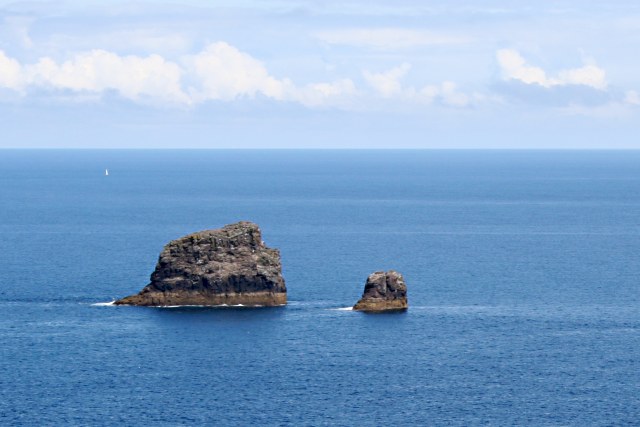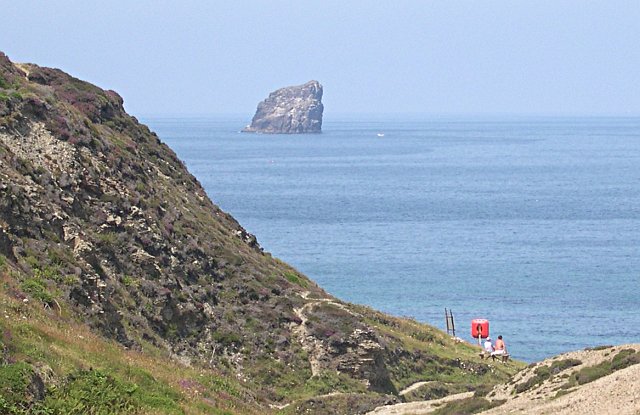Bawden Rocks on:
[Wikipedia]
[Google]
[Amazon]

 Bawden Rocks ( kw, Meyn Bodyn), also known as Cow and Calf or Man and His Man, are a pair of small
Bawden Rocks ( kw, Meyn Bodyn), also known as Cow and Calf or Man and His Man, are a pair of small

 Bawden Rocks ( kw, Meyn Bodyn), also known as Cow and Calf or Man and His Man, are a pair of small
Bawden Rocks ( kw, Meyn Bodyn), also known as Cow and Calf or Man and His Man, are a pair of small island
An island (or isle) is an isolated piece of habitat that is surrounded by a dramatically different habitat, such as water. Very small islands such as emergent land features on atolls can be called islets, skerries, cays or keys. An island ...
s approximately one mile north of St Agnes Head, off the coast of Cornwall
Cornwall (; kw, Kernow ) is a historic county and ceremonial county in South West England. It is recognised as one of the Celtic nations, and is the homeland of the Cornish people. Cornwall is bordered to the north and west by the Atlantic ...
, England, United Kingdom. The larger of the two rocks stands around above the high water mark.
The rocks are popular with swimmers, divers
Diver or divers may refer to:
*Diving (sport), the sport of performing acrobatics while jumping or falling into water
*Practitioner of underwater diving, including:
**scuba diving,
**freediving,
**surface-supplied diving,
**saturation diving, a ...
, anglers and trawler fishermen, being home to a wide range of marine life. Sea anemone
Sea anemones are a group of predation, predatory marine invertebrates of the order (biology), order Actiniaria. Because of their colourful appearance, they are named after the ''Anemone'', a terrestrial flowering plant. Sea anemones are classifi ...
s, molluscs
Mollusca is the second-largest phylum of invertebrate animals after the Arthropoda, the members of which are known as molluscs or mollusks (). Around 85,000 extant taxon, extant species of molluscs are recognized. The number of fossil sp ...
and crustacean
Crustaceans (Crustacea, ) form a large, diverse arthropod taxon which includes such animals as decapods, seed shrimp, branchiopods, fish lice, krill, remipedes, isopods, barnacles, copepods, amphipods and mantis shrimp. The crustacean group ...
s of various types cling to the rock walls below the surface of the sea, together with marine animals such as the threatened broad sea fan.
The rocks are also a nesting ground for a number of seabird species, including razorbill
The razorbill, razor-billed auk, or lesser auk (''Alca torda'') is a colonial seabird and the only extant member of the genus '' Alca'' of the family Alcidae, the auks. It is the closest living relative of the extinct great auk (''Pinguinis impe ...
s, cormorant
Phalacrocoracidae is a family of approximately 40 species of aquatic birds commonly known as cormorants and shags. Several different classifications of the family have been proposed, but in 2021 the IOC adopted a consensus taxonomy of seven ge ...
s, guillemot
Guillemot is the common name for several species of seabird in the Alcidae or auk family (part of the order Charadriiformes). In British use, the term comprises two genera: ''Uria'' and ''Cepphus''. In North America the ''Uria'' species are c ...
s, great black-backed gull
The great black-backed gull (''Larus marinus'') is the largest member of the gull family. Described by the Cornell Lab of Ornithology as "the king of the Atlantic waterfront", it is a very aggressive hunter, pirate, and scavenger. It breeds on t ...
s and puffin
Puffins are any of three species of small alcids (auks) in the bird genus ''Fratercula''. These are pelagic seabirds that feed primarily by diving in the water. They breed in large colonies on coastal cliffs or offshore islands, nesting in crev ...
s.
A local legend claims that the rocks were thrown out to sea by a child-eating giant
In folklore, giants (from Ancient Greek: '' gigas'', cognate giga-) are beings of human-like appearance, but are at times prodigious in size and strength or bear an otherwise notable appearance. The word ''giant'' is first attested in 1297 fr ...
called Bolster, after whom Bolster Day was named.
References
Uninhabited islands of Cornwall {{Cornwall-geo-stub